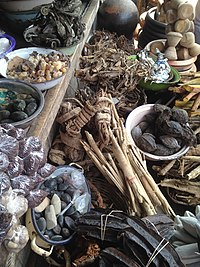
Photo from wikipedia
Although photobiomodulation (PBM) has proven promising to treat wounds, the lack of univocal guidelines and of a thorough understanding of light–tissue interactions hampers its mainstream adoption for wound healing promotion.… Click to show full abstract
Although photobiomodulation (PBM) has proven promising to treat wounds, the lack of univocal guidelines and of a thorough understanding of light–tissue interactions hampers its mainstream adoption for wound healing promotion. This study compared murine and human fibroblast responses to PBM by red (635 ± 5 nm), near-infrared (NIR, 808 ± 1 nm), and violet-blue (405 ± 5 nm) light (0.4 J/cm2 energy density, 13 mW/cm2 power density). Cell viability was not altered by PBM treatments. Light and confocal laser scanning microscopy and biochemical analyses showed, in red PBM irradiated cells: F-actin assembly reduction, up-regulated expression of Ki67 proliferation marker and of vinculin in focal adhesions, type-1 collagen down-regulation, matrix metalloproteinase-2 and metalloproteinase-9 expression/functionality increase concomitant to their inhibitors (TIMP-1 and TIMP-2) decrease. Violet-blue and even more NIR PBM stimulated collagen expression/deposition and, likely, cell differentiation towards (proto)myofibroblast phenotype. Indeed, these cells exhibited a higher polygonal surface area, stress fiber-like structures, increased vinculin- and phospho-focal adhesion kinase-rich clusters and α-smooth muscle actin. This study may provide the experimental groundwork to support red, NIR, and violet-blue PBM as potential options to promote proliferative and matrix remodeling/maturation phases of wound healing, targeting fibroblasts, and to suggest the use of combined PBM treatments in the wound management setting.
Journal Title: Applied Sciences
Year Published: 2020
Link to full text (if available)
Share on Social Media: Sign Up to like & get
recommendations!